
Busan, officially Busan Metropolitan City, is South Korea's second most populous city after Seoul, with a population of over 3.4 million inhabitants as of 2017. Formerly romanized as Pusan, it is the economic, cultural and educational center of southeastern South Korea, with its port being South Korea's busiest and the sixth-busiest in the world. The surrounding "Southeastern Maritime Industrial Region" is South Korea's largest industrial area. The large volumes of port traffic and urban population in excess of 1 million make Busan a Large-Port metropolis using the Southampton System of Port-City classification. As of 2019, Busan Port is primary port in Korea and the world's sixth-largest container port.

Ulsan, officially the Ulsan Metropolitan City, is South Korea's seventh-largest metropolitan city and the eighth-largest city overall, with a population of over 1.1 million inhabitants. It is located in the south-east of the country, neighboring Busan to the south and facing Gyeongju to the north.
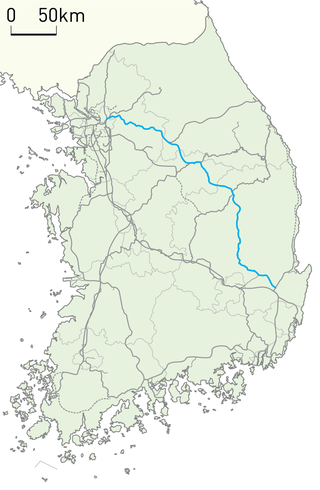
The Jungang line is a railway line connecting Cheongnyangni in Seoul to Moryang in Gyeongju in South Korea, traversing central South Korea from the northwest to the southeast. It is also referred to as the rail line of the Seoul Metropolitan Subway from Yongsan station to Jipyeong station. The section from Cheongnyangni to Dodam was designated as a semi-high-speed railway.

The Donghae Nambu Line (Korean: 동해남부선) is a railway line connecting Busan to Pohang in South Korea. The line runs along South Korea's east coast. On December 30, 2016, it was merged into Donghae Line.
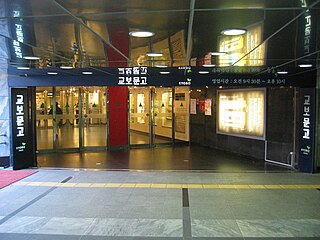
Kyobo Book Centre is the largest bookstore chain in South Korea. It has ten stores in seven cities, with the flagship Main Store, or Gwanghwamun-jeom in Seoul, which is located in the basement of the Kyobo Building, at 1 Jong-ro, Jongno-gu in Seoul's central business district.

Yeongdeungpo District is an administrative district in southwest Seoul, South Korea. Although the origin of the name is uncertain, the first two syllables are thought to be from "yeongdeung" (靈登) or "divine ascent", a shamanic rite. The third syllable is "po", representing the bank of a river (浦), referring to the district's position on the Han River. The 2006 population was 408,819.

The Mugunghwa-ho (Korean: 무궁화호) is a class of train operated by Korail, main railway operator of South Korea. Mugunghwa trains are Korail's slowest tier of trains stopping at a number of towns and villages, and operating over a number of lines that are not served by other trains. Journey times are generally twice that of KTX trains and 25% longer than ITX express trains.

The Saemaeul-ho, formerly known as the Saemaul-ho and Saemaul Express, is a class of train operated by Korail, the national railroad of South Korea, since February 8, 1969. Before the introduction of the KTX express trains, the Saemaeul-ho was the fastest class of trains in South Korea, making the journey from Seoul to Busan in less than 5 hours. Saemaeul trains operated on several lines, but they now only operate on the Janghang Line.

Dongjak District (Dongjak-gu) is one of the 25 gu that make up the city of Seoul, South Korea. Its name was derived from the Dongjaegi Naruteo Ferry, on the Han River which borders the district to the north. It was the 17th gu created in Seoul, after being separated from Gwanak District on 1 April 1980.
Seoul, the capital and largest city in South Korea, accounts for only 0.6% of the country's total land area, yet it is home to around 19% of the population. The population density in Seoul demands a great deal of the city's transportation systems, which are regarded by many as among the best and most advanced in the world. Seoul is very well connected by its subway and bus systems, and the city is also very supportive of pedestrian foot travel. In 2006 it won the Sustainable Transport Award.

Yeongdeungpo station is a ground-level railway station in Seoul, South Korea. The station is located in Yeongdeungpo Dong, Yeongdeungpo-gu, and is a stop on the Gyeongbu Line, Honam Line and Seoul Subway Line 1. The station is integrated into the Yeongdeungpo Lotte Department Store. Located in the station are Lotteria, Dunkin' Donuts, Krispy Kreme, and KFC.

Bupyeong District is one of the 10 administrative divisions that comprise Incheon, South Korea. Bupyeong-gu comprises an area of 12.35 square miles, and has a population of 508,587. It is located north of Namdong-gu, east of Seo-gu, and south of Gyeyang-gu. The city of Bucheon, in neighboring Gyeonggi Province, comprises its eastern limit.

Sangil-dong station is the subway station of Line 5 in Gangdong-gu, Seoul. Seoul Metro have extended the subway line from this station to Hanam Geomdansan in the nearby city of Hanam.

Nam District (Nam-gu) is a district of Ulsan, South Korea. Its name literally means "South Ward".
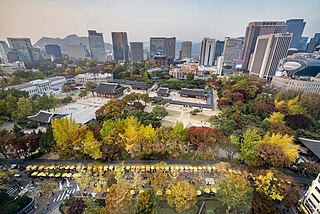
Seoul, officially Seoul Special City, is the capital of the Republic of Korea (ROK), commonly known as South Korea, and the country's most extensive urban center. The broader Seoul Capital Area, encompassing Gyeonggi province and Incheon metropolitan city, emerged as the world's fourth largest metropolitan economy in 2014, trailing only Tokyo, New York City, and Los Angeles, hosting more than half of South Korea's population. Although Seoul's population peaked at slightly over 10 million, it has gradually decreased since 2014, standing at approximately 9.97 million residents as of 2020. Seoul is the seat of the South Korean government.

Ulsan Station (Tongdosa) is a South Korean high-speed rail station located in Samnam-eup, Ulju-gun. It is on Gyeongbu High Speed Railway and named Ulsan Station with subname Tongdosa, which is located in Yangsan, nearer than downtown Ulsan from the station. The existing Ulsan Station in Samsan-Dong, Nam-gu has been renamed to Taehwagang station.
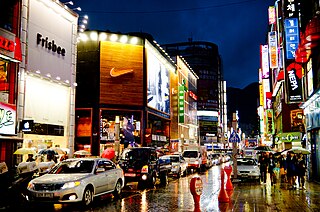
Seomyeon is the commercial center and transportation hub in Busanjin-gu, Busan, South Korea. Seomyeon is also the most crowded area in Busan, having an average floating population of 1,000,000 a day.
Samsan-dong is a dong, or neighborhood, of Nam-gu in Ulsan, South Korea. Samsan literally translates as "three mountains". It is Ulsan's downtown area.
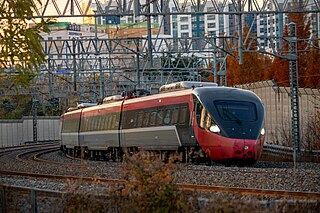
The Intercity Train eXpress-Saemaeul abbreviated as ITX-Saemaeul (Korean: ITX-새마을) is a class of train operated by Korail, the national railroad of South Korea, it was introduced on May 12, 2014, to replace the Saemaeul-ho. The new ITX-Saemaeul trains have a faster average speed of 150 kilometers per hour. The name was taken from the Saemaul Undong after a public competition to determine the new train's name.

The Donghae Line is a railway line connecting Busanjin station to Yeongdeok in South Korea. The literal meaning of its name, the "East Sea Line," reflects its position along the nation's East coast. It merged with the Donghae Nambu Line on December 30, 2016, and will merge with the Donghae Bukbu Line.


















